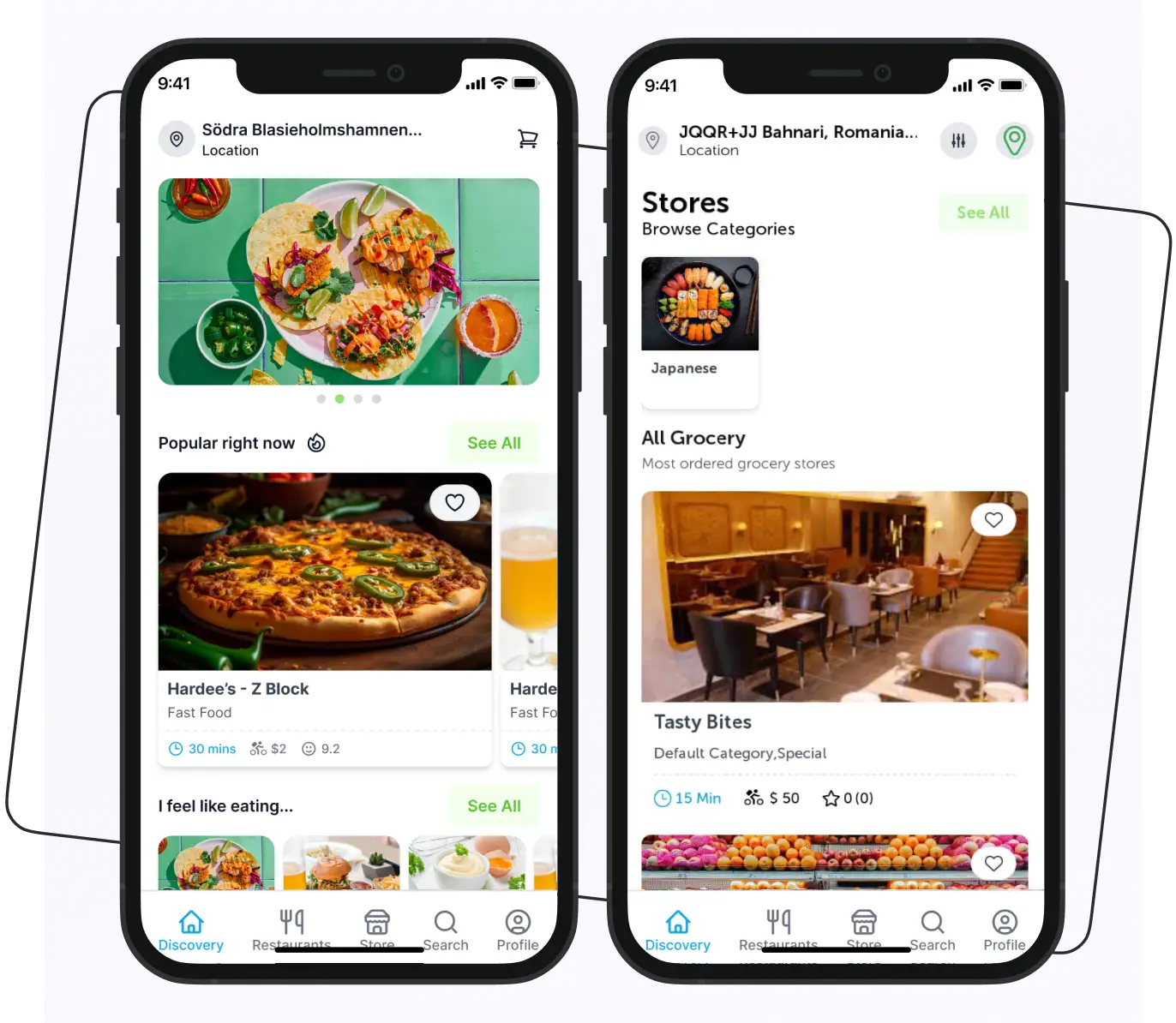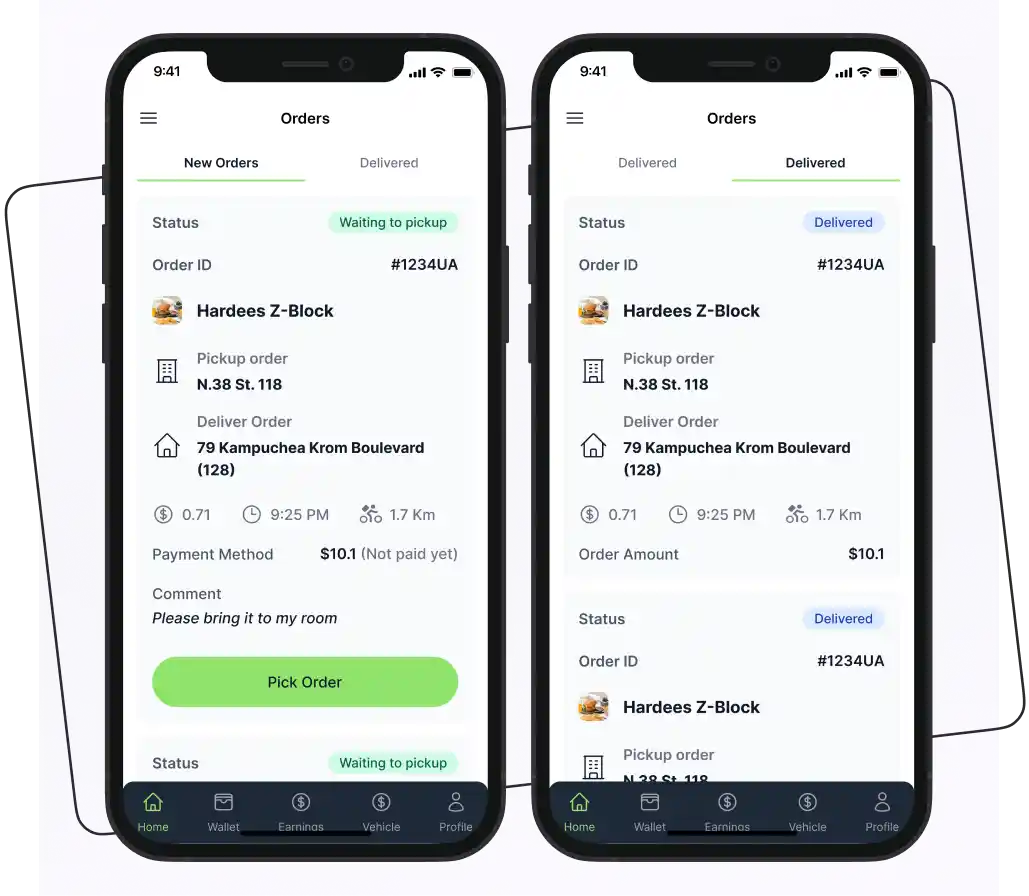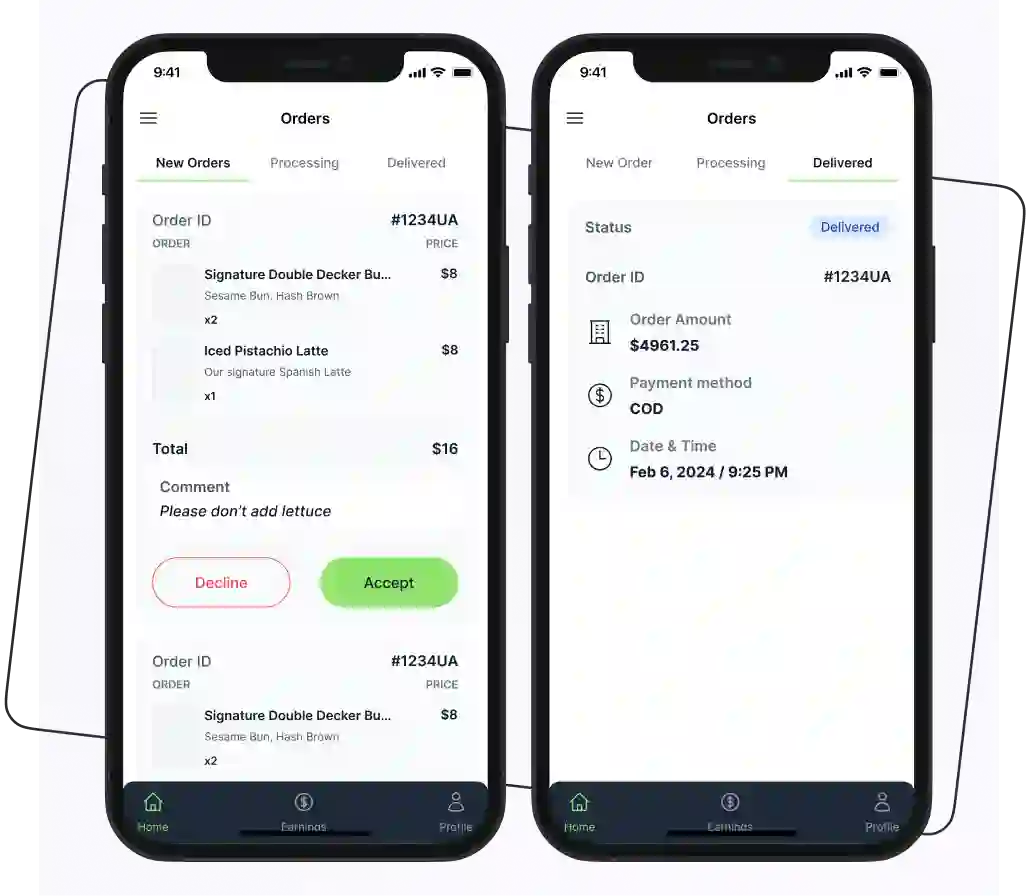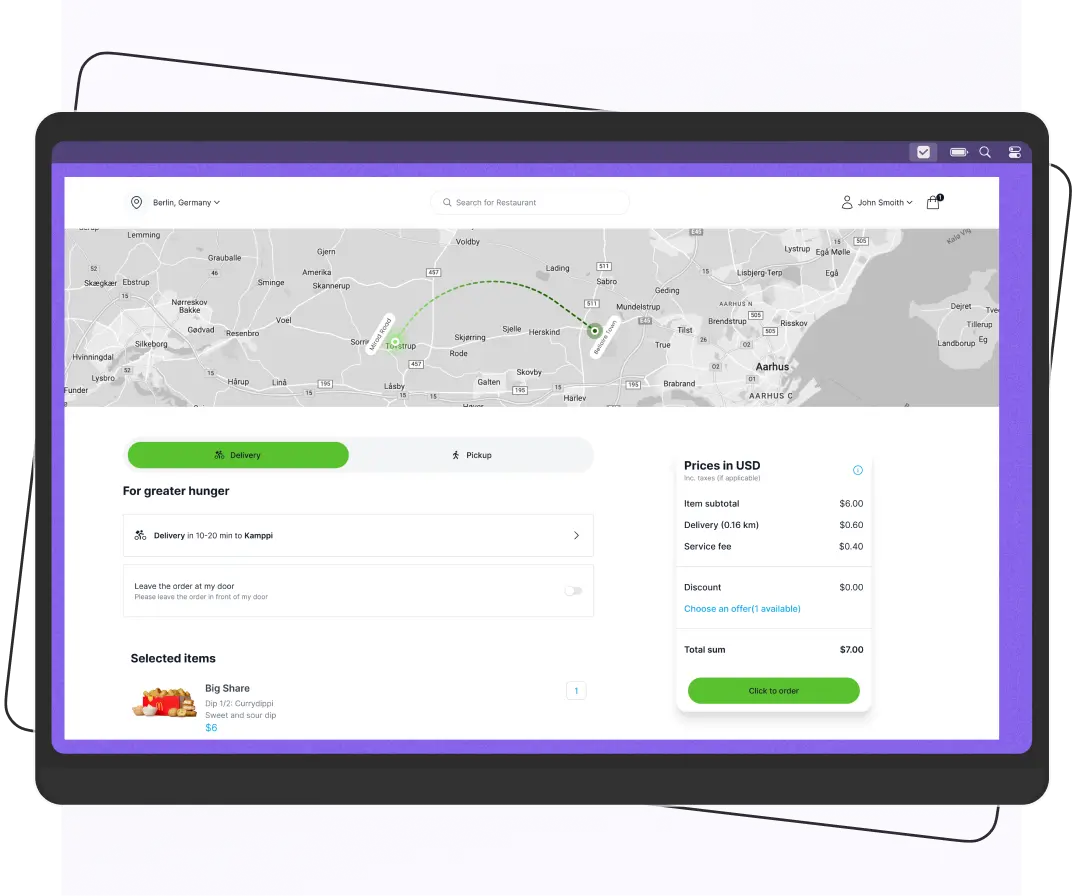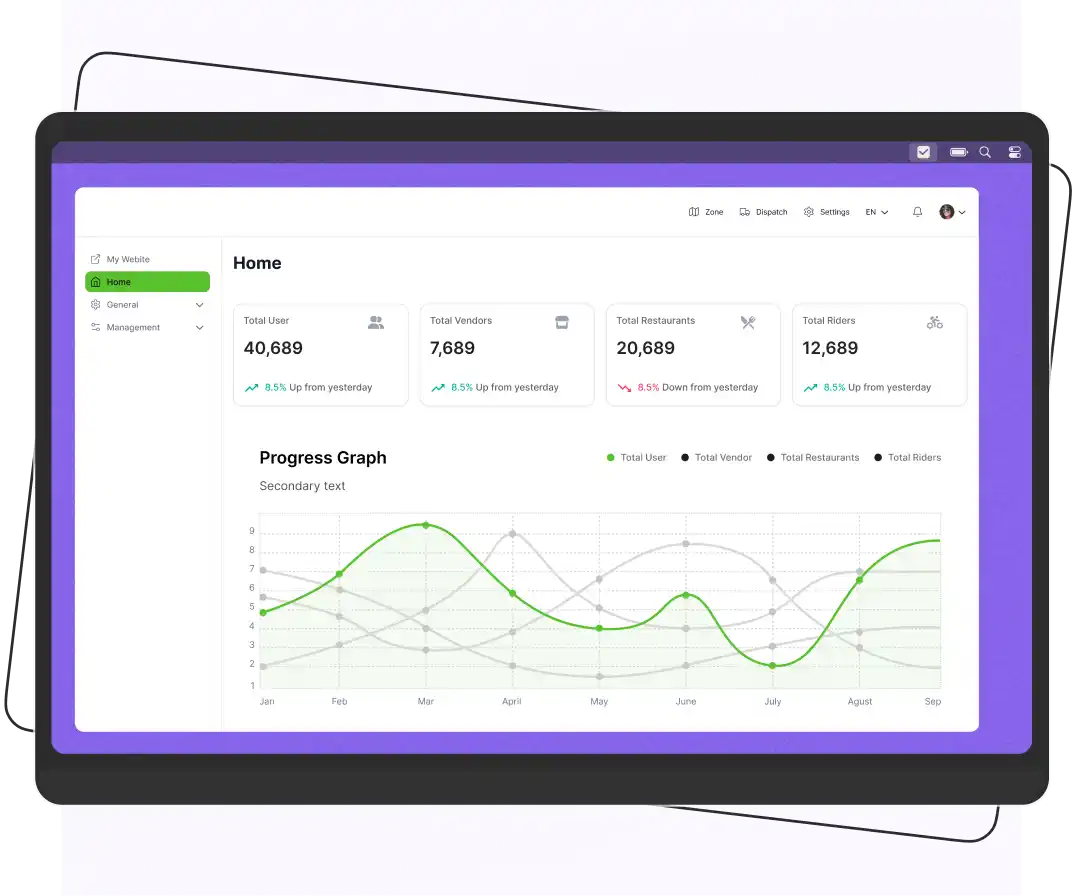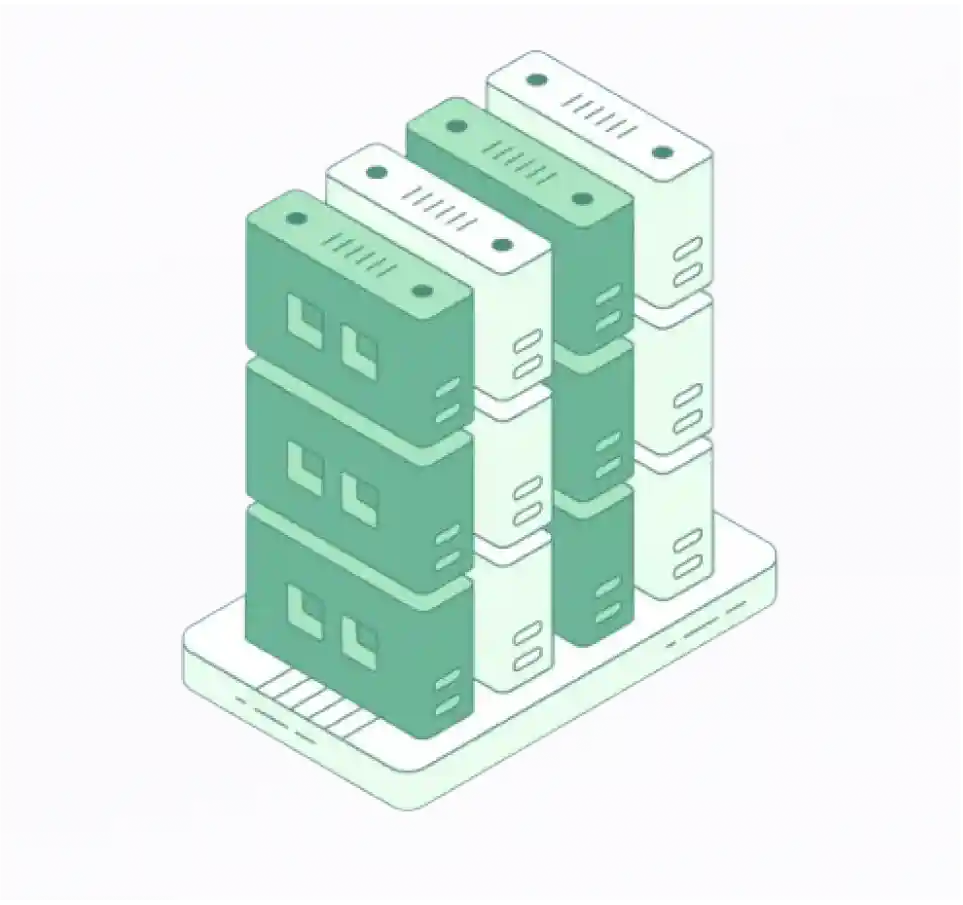
Key Takeaways
- A flower delivery app boosts sales, automates orders, and enhances customer experience.
- The market is growing, projected to hit $12.76 billion by 2033.
- Include features like order management, payments, and delivery tracking.
- Challenges include competition, seasonal demand, and quality control.
Missed deliveries? Lost sales? In today’s $12.7B flower delivery market, florists who go digital are winning big. A custom flower delivery app lets you take orders 24/7, delight customers with real-time tracking, and grow revenue faster than ever.
Florist delivery apps redefine how people express themselves and connect with others by sending flowers. Whether it’s a surprise birthday bouquet or a heartfelt arrangement for condolences, these apps make gifting effortless, timely, and deeply personal.
For florists, it’s more than just delivering flowers; it’s about crafting unforgettable experiences that keep customers coming back for more.
Let’s explore how creating a standout florist delivery app can put your brand at the heart of life’s most special moments.
What is a Flower Delivery App?
The flower delivery app is an on-demand software solution designed to quickly deliver freshly picked flowers to customers’ doorsteps. Flower apps are made exclusively for florists and connect flower merchants and florists with their target customers who are searching for online flower-ordering platforms.
The main purpose of creating the online flower app is to:
- Simplify the ordering process.
- Help the flower shops strengthen their online presence and boost their sales.
- Provide your customers access to an online product catalog.
- Help the florists expand their business efficiently.
How Does Online Flower Delivery Work?
Here is a step-by-step process that shows how the flower app works.

- App Download and User Registration
The user downloads the flower delivery app and creates an account by providing their personal and contact information.
- Browse Flower
The user can browse through the app’s catalog of flower arrangements, bouquets, and other floral products. The app organizes these by occasion, flower type, color, price, and other filters to help the user find what they’re looking for.
- Select Flowers and Customize
Once the user finds the desired floral arrangement, they can customize it further by adding a personal message, selecting the delivery date and time, and providing the recipient’s details.
Supercharge your deliveries with Enatega.
Get A Quote- Payment Processing
The user then proceeds to checkout and securely pays for the order using various payment methods integrated into the app, such as credit/debit cards, digital wallets, or in-app payment options.
- Order Placement and Tracking
After the payment is successful, the order is placed, and the user can track its status through the app. This includes notifications on when the order has been processed, prepared, and delivered.
- Delivery Logistics
The florist delivery app works with local florists or has its own distribution network to ensure the flowers are freshly picked, arranged, and delivered to the recipient on the requested date and time.
- Customer Support
The app provides customer support channels, such as in-app chat, email, or phone, to assist users with any order-related inquiries or issues.
- Feedback and Repeat Orders
Users can provide feedback on their experience, which helps to improve the app and its offerings. The app also encourages repeat orders by providing loyalty programs, discounts, and personalized recommendations.
Flower Delivery App vs. Traditional Florist Shop
| Aspect | Flower Delivery App | Traditional Florist Shop |
| Accessibility | Available 24/7; customers can browse and order anytime from anywhere. | Limited to store hours; customers must visit in person or call during open hours. |
| Convenience | The entire process, browsing, payment, and tracking, is done via a mobile device. | Requires physical visit or phone call; less convenient for busy or remote customers. |
| Product Range | Large catalog with filters (occasion, price, flower type) and easy comparisons. | Limited by in-store inventory and display space. |
| Customization | Easy personalization options like gift notes, delivery time, and add-ons (chocolates). | Can offer custom arrangements, but personalization usually happens in-store only. |
| Delivery Speed | Often offers same-day or scheduled delivery with tracking. | Delivery available, but tracking is limited and may require follow-up calls. |
| Customer Reach | Can target a wider audience, including customers outside the local area. | Primarily serves local walk-in customers; limited regional reach. |
| Overheads | Lower need for large retail space; more budget can go into marketing and delivery. | Requires physical storefront maintenance, decor, and higher utility costs. |
| Scalability | Can easily expand to multiple locations or regions via partnerships with local florists. | Expansion requires opening new physical stores, which is costly and time-consuming. |
Pros and Cons of Flower Delivery Apps
Flower delivery apps have pros and cons that business owners and customers should consider. So, let’s look at them.
| Pros | Cons |
Flower delivery apps provide customers with the convenience of browsing and purchasing flowers without leaving home. With just a few taps on a mobile phone, they can send the flowers to their friends and family members’ doorsteps without physically visiting stores to purchase. | The flower delivery market is highly competitive, with many established players and new entrants. Standing out and building a loyal customer base can be challenging. |
| Flower apps offer an extensive selection of floral varieties, arrangements, and customization options. This allows customers to create personalized gifts that cater to the recipient’s tastes. | Users may experience quality issues. For example, if the flowers they receive aren’t as colorful and fresh-looking as the pictures on the app, users may be disappointed. This kind of quality disparity may cause them to have lower expectations for the entire giving experience. |
| The flower apps help users schedule same-day deliveries and surprise recipients on time. Due to these fast response times, flower apps are the best choice if you need to deliver flowers at the last minute. | The digital nature of flower apps may diminish the personal touch and emotional connection that some customers seek when purchasing flowers. |
| Several flower bouquet apps allow users to customize their orders according to their needs. With this feature, customers add personal touches like cards and chocolates as part of their gift experience. | Ensuring reliable, on-time flower delivery across multiple locations can be logistically complex and require careful supply chain management. |
| Users can keep track of their order delivery in real-time. This feature provides peace of mind throughout the delivery process. In addition, the flower apps are available around the clock. | Ordering flowers online sometimes includes hidden fees. Some flower delivery companies charge extra fees for same-day or next-day delivery. Also, some charge additional fees for special wrapping, card messages, and other services that may be included at no extra charge when ordering in person. |
| The flower delivery app solutions help businesses to streamline their operations and serve customers better. | Building long-term customer loyalty in the flower delivery business can be challenging, as customers may be price-sensitive and willing to switch between providers. |
| Business owners can keep track of all their business activities from a single platform without any hassle. | Flower demand is highly seasonal, with major spikes around events like Valentine’s Day, Mother’s Day, etc. This can lead to capacity challenges and fluctuations in revenue. |
Features of an Online Flower Delivery App
Below are some features of an online flower delivery app.
User App
| Features | Description |
| Easy Login and Registration | The on-demand flower delivery app solution allows users to sign in with their email and social media accounts, such as Facebook, Instagram, and others. The registration process is easy and simple for users. |
| Advanced Search | Users use an advanced search filter and search the flowers based on pricing, occasion, location, florist name, and others. This makes it easier for users to search the full catalog of available flowers efficiently and find the perfect options that meet their needs. |
| Payment Methods | Customers can conveniently select their preferred payment method and complete transactions seamlessly. The payment process is designed to be straightforward and efficient, allowing users to make purchases or pay bills with minimal friction. |
| Apply Discounts and Offers | This feature enables users to easily apply a discount or promotional code to their order, which will then automatically deduct the discount amount from the total cost. This functionality provides customers with the flexibility to take advantage of special offers, sales, or other discounts that may be available, helping them save money on their purchases. |
| Schedule Delivery | Users are provided with the ability to customize the delivery schedule for their orders. It allows them to specify if they need the items delivered within an hour or at a particular time that is most convenient for them. |
| Order Tracking | With this feature, users can track their deliveries and find out the exact location where their order has been delivered. It gives peace of mind to users and avoids any misunderstanding. |
| Push Notifications | Users receive notifications on the app regarding their orders, new deals, special promotions, and discounts. |
| Review and Rating | The users can leave a review and rate the delivery service based on their experience. This review and rating feature helps future customers make better decisions. Also, the flower shop owners know where they lack, what customers want, and more. |
Flower Store App
| Features | Description |
| Sign in and Sign up | Creating and setting up an account for a flower shop is a straightforward and user-friendly process. The account setup procedure guides the owner through the necessary steps to establish their business profile within the platform, ensuring a seamless onboarding experience. |
| Manage Orders | The flower store owners can manage their orders from the platform, and they can also view the user’s data, address, name, and schedule. |
| Track Earnings and Sales | The owners can keep track of their earnings and sales. They can track key metrics such as total revenue, order volumes, average order values, and sales trends over time. |
| Real-time Tracking | The flower shop owner is provided with the ability to track and manage the delivery drivers’ information and performance. This feature gives the owner visibility into the drivers’ contact details, delivery schedules, and real-time status updates on the order fulfillment process. |
| Set Availability | From the app, the owner can conveniently set their business’s availability and operating hours. This feature provides the owner with the flexibility to configure and manage the shop’s hours of operation. |
Rider App
| Features | Description |
| Rider Login | The riders create an account on the app by providing some basic information such as name, email, phone number, and location. |
| Set Availability | The riders associated with the flower shop platform are provided with the capability to set their availability based on their delivery schedules. This feature gives the riders flexibility in managing their workload and time commitments. |
| Push Notifications | Riders receive alerts or notifications when a new customer order has been received and is ready for fulfillment. This immediate notification system ensures that the riders are promptly informed of the incoming delivery requests, allowing them to respond and prepare accordingly. |
| Update the Delivery Status | On the rider app, riders can update the status when they pick up and deliver the order. This order status tracking feature helps the riders to provide real-time visibility to the flower shop owners and customers regarding the delivery progress. |
Admin Panel
| Features | Description |
| Dashboard | The admin dashboard serves as the central hub for managing and monitoring all the business operations. This dashboard provides the owners and managers with a combined view of the various activities that are vital for the smooth running of the business. |
| Order Management | The admin can add, delete, and manage all incoming orders from the dashboard. It helps them streamline the process of order management. |
| Manage Sales and Earnings | The administrative dashboard enables the owners and managers to closely monitor and analyze the business’s sales and earnings on a daily, monthly, and annual basis. |
| Manage Discounts, Offers, Coupons | From the dashboard, the shop owners can edit and update new offers, discounts, and coupons that can be tailored to specific occasions or events. |
Steps for Building the Flower Delivery App
Here is a step-by-step process for building the florist delivery app.

1. Planning and Research
Before the florist app development, research is essential. It helps you to understand local flower vendors, current market trends, and customer interests.
This information will create the foundation of the app to help you in building an on-demand flower delivery app for your company. Thus, make sure to conduct in-depth research before developing an app.
2. Competitors Analysis
Understanding the competitors is the next stage. The majority of your app’s success is determined by competitor research.
You must analyze your competition if you want to stay ahead. It will assist you in creating the greatest app for your customers. Therefore, you must be aware of your competitors when deciding to develop a flower delivery service app.
3. Select the App Features
After research, decide on the app features. Select those features that are necessary for your app and make your app attractive to the users. Also, include those features that are not present in your competitor’s app.
4. Start On-Demand Flower Delivery App Development
Now, it’s time to develop the flower app. This phase can be divided into three steps:
UI/UX Design: The key elements of every online delivery app are UI and UX. If you’re going to create a flower delivery app, you should consider how professional and distinctive the design will be. Always design the app that will help you establish your brand.
Front-end Development: In this phase, build components that interact with users. Develop smooth and intuitive user interactions, such as smooth scrolling and animations, to improve the overall user experience.
Backend Development: Design and develop a robust API layer to handle all the business logic, data management, and integration with external services (e.g., payment gateways, inventory management, and more).
Implement a suitable database solution (e.g., SQL, NoSQL) to store and manage product information, user data, order details, and other relevant information.
5. Testing and Launching
When the app development phase is complete, start the app testing. Test the delivery app and remove all the bugs and errors. Make sure your app is error-free before submitting it to app stores.
6. Marketing
Once the application is launched, it is required to brand the application. Start the marketing of the app on different platforms. Therefore, more people will know about your flower ordering app. Use social media platforms, send emails, offer discounts, and more to attract customers.
Cost to Develop a Flower Delivery App
The cost of developing the app for flower delivery is influenced by several factors such as:
- Complexity of the app’s features
- Hourly rates of the development team
- Location of the development team
- Use of third-party services and integrations
- Ongoing maintenance and updates are required
| Cost Component | Estimated Cost |
| App Design | $5,000 – $10,000 |
| App Development (iOS & Android) | $25,000 – $50,000 |
| Backend Server Development | $10,000 – $20,000 |
| Database Setup and Integration | $3,000 – $5,000 |
| Payment Gateway Integration | $2,000 – $5,000 |
| Third-Party API Integration (e.g., maps) | $3,000 – $7,000 |
| Quality Assurance and Testing | $5,000 – $10,000 |
| Deployment and App Store Submissions | $1,000 – $3,000 |
| Maintenance and Updates (first year) | $5,000 – $10,000 |
| Total Estimated Cost | $59,000 – $120,000 |
Challenges in Building the Flower Delivery Service
Look at the table below and understand the challenges that are associated with building a flower sending app.
| Challenges | Description | Solution |
| Inventory Management | Difficulty in tracking stock levels and ensuring availability. | Implement a real-time inventory management system. |
| Logistics and Delivery | Coordinating timely deliveries can be complex. | Partner with local courier services and use GPS tracking. |
| Payment Processing | Handling secure and reliable payment transactions. | Integrate trusted payment gateways with encryption. |
| Seasonal Demand Fluctuations | Managing inventory and staffing during peak seasons. | Develop a flexible staffing plan and adjust inventory levels. |
| Customer Service | Addressing customer inquiries and complaints effectively. | Set up a responsive customer support system (chat, email). |
| Data Security | Protecting customer data from breaches. | Implement robust cybersecurity measures and regular audits. |
Online Flower Delivery Services in the USA
What is the best app to deliver flowers?
Below is a list of the best apps for flower delivery in the USA.
Farmgirl Flowers
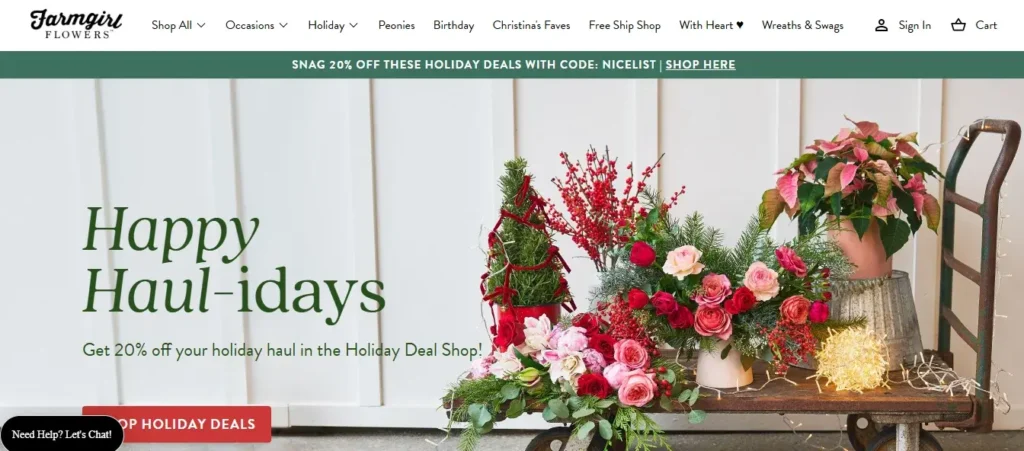
Farmgirl Flowers is a delightful choice for those who appreciate the beauty of locally sourced blooms. Each bouquet is crafted with seasonal flowers, ensuring every delivery feels fresh and unique. Farmgirl Flowers brightens your day and supports local growers, making it a feel-good choice for any occasion.
| Pros | Cons |
| Prioritize eco-friendly packaging | Slightly more expensive than other flower services |
| Locally sourced flowers | |
| Aesthetically pleasing arrangements |
Roses Only

For rose enthusiasts, Roses Only is the best place. This service specializes in delivering premium quality roses. With various arrangements tailored for different occasions, Roses Only ensures that each bouquet conveys heartfelt emotions. Whether you’re celebrating a special moment or simply wishing to brighten someone’s day, their exquisite rose selections are sure to impress and create lasting memories.
| Pros | Cons |
| A variety of flower types is available | Some users face delivery issues due to shipping delays, bad weather, etc. |
| Fast delivery | |
| Order tracking |
1-800-Flowers
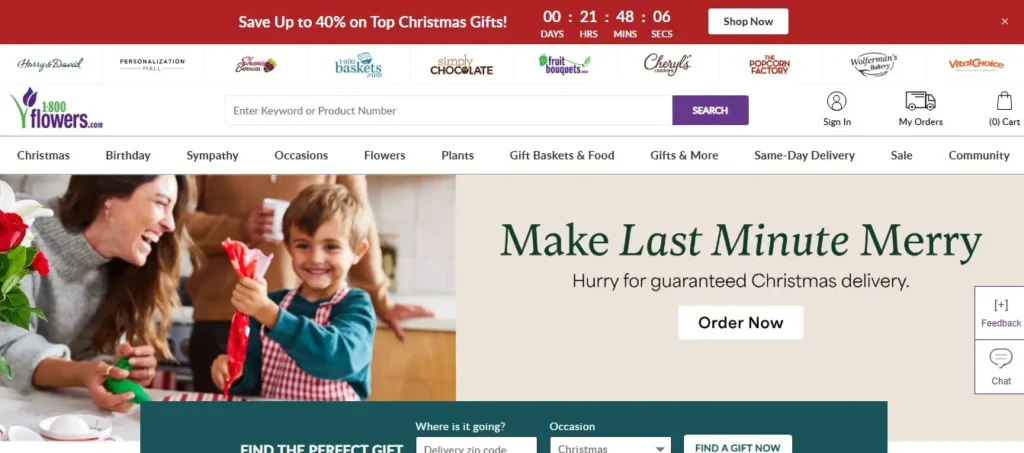
As one of the most recognized names in floral delivery, 1-800-Flowers offers an impressive array of flowers, plants, and gifts that cater to every taste and occasion. Their extensive selection, combined with convenient same-day delivery options, makes it easy to send joy at a moment’s notice.
Whether it’s a birthday, anniversary, or just because, 1-800-Flowers ensures that your thoughtful gesture arrives beautifully presented and on time.
| Pros | Cons |
| Free shipping | A little expensive |
| Dedicated service team | Flowers delivered with no message |
| Special offers and discounts | |
| Users can customize the delivery schedule |
BloomsyBox
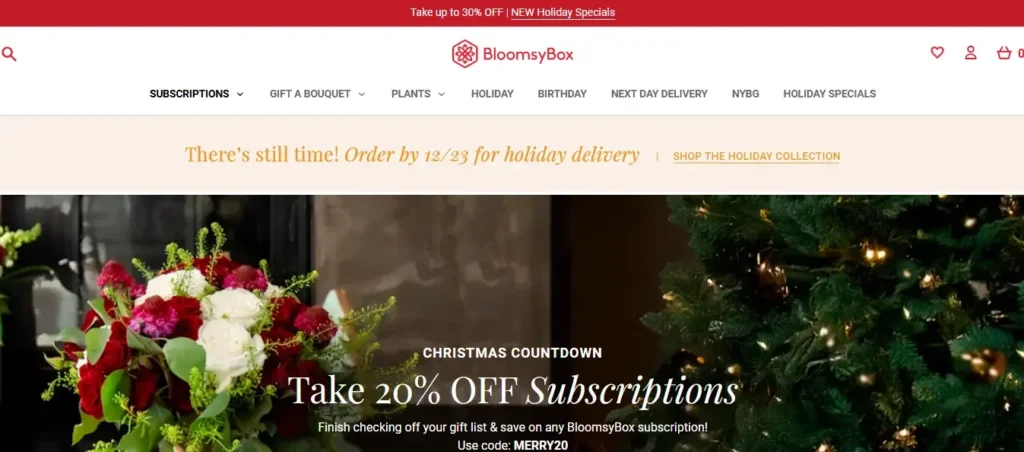
If you’re looking for a delightful surprise delivered to your door every month, BloomsyBox is the perfect subscription service for you. Specializing in fresh, seasonal flowers, each delivery is a curated experience that showcases the best blooms available.
| Pros | Cons |
| Lower costs per stem | Some bouquets may contain flowers that are poisonous to pets. |
| Deliver fresh flowers | Some users face shipping issues |
| Customization | |
| Seasonal and exotic selections | |
| Eco-friendly packaging |
The Sill

The Sill stands out by blending the beauty of flowers with the charm of houseplants. This service offers a wide selection of both potted plants and fresh floral arrangements, catering to plant lovers and flower enthusiasts.
| Pros | Cons |
| A variety of high-quality plants | Customers face delivery issues |
| Attractive packaging | |
| Great customer service | |
| Affordable |
Tips and Tricks for Online Flower Delivery
Below are some tips and tricks for running a successful online flower delivery business.
- Create a proper business plan to help you run a flower delivery business.
- Highlight your floral offerings with high-quality photos and creative names.
- Pack your products with good packaging that attracts customers.
- Consider offering complementary products like vases, chocolates, or greeting cards.
- Include a range of floral arrangements for different occasions (birthdays, weddings, anniversaries, etc.).
- Run contests or giveaways to increase your follower base and drive traffic to your website.
- Ensure your website is user-friendly, mobile-responsive, and visually appealing.
- Use platforms like Instagram and Facebook to showcase your floral designs and engage with customers.
- Offer quick responses to customer inquiries via chat or email.
- Collaborate with local florists to expand your reach and improve product freshness.
- Send regular updates about new products, promotions, and tips for flower care.
- Create special promotions for holidays like Valentine’s Day, Mother’s Day, and Christmas.
- Keep an eye on floral trends and adapt your inventory to meet changing customer demands.
Case Study: Petal Express – A Flower Delivery App
Introduction
PetalExpress is a mid-sized florist shop based in Denver, Colorado, specializing in seasonal bouquets and event arrangements. Before 2023, they relied solely on walk-in customers, phone orders, and a basic website.
Their average monthly revenue was around $18,000, and most orders were for weddings or special events. They face an inconsistent cash flow during the off-season.
Challenges Faced Before the App
- Limited Ordering Hours – Orders were only possible during store hours (10 AM – 7 PM).
- Missed Sales – They missed last-minute purchases, especially for birthdays and anniversaries.
- No Real-Time Tracking – Customers often called to ask, “Has my order gone out yet?”
- High Marketing Costs – They relied on costly newspaper ads and wedding fairs for new customers.
Solution Implemented
In February 2023, PetalExpress partnered with a local app development agency to launch a custom flower delivery app.
The app included:
- 24/7 Online Ordering with same-day and next-day delivery options
- Real-Time Delivery Tracking integrated with Google Maps API
- Personalization Features (gift notes, wrapping styles, and custom bouquet builder)
- Loyalty Program (points for each purchase, redeemable for discounts)
- Push Notifications for seasonal offers and reminders like “Mother’s Day is this Sunday”
FAQs
1. What’s the best way to send flowers to someone?
The best way to send flowers is to use a reputable online florist or a local shop that offers delivery services. Make sure you select a bouquet that matches the recipient’s taste and the occasion.
2. Can you order flowers with DoorDash?
Yes, you can order flowers through DoorDash in some areas, as they partner with local florists and shops for delivery. Just check the app or website for availability in your location.
3. What is better than flower delivery?
Better than flower delivery might be a personalized gift, such as a custom piece of jewelry or a heartfelt handwritten letter, which can create a more lasting emotional impact. Experiences like a surprise outing or a home-cooked meal can also be more memorable.
4. Which online flower delivery is the best?
The best online flower delivery services are 1-800-Flowers for variety and FTD for quality arrangements. Other options include Farmgirl Flowers, Teleflora, UrbanStems, etc.
5. Why is flower delivery so expensive?
Flower delivery can be expensive due to several factors:
Freshness and Quality: Maintaining freshness requires careful handling and transportation, which can increase costs.
Labor: Skilled florists often design arrangements, adding to labor expenses.
Shipping Costs: Delivery fees can be high, especially for same-day or specialized services.
Seasonal Demand: Prices may rise during holidays or special occasions when demand is high.
Overhead: Businesses experience costs for supplies, packaging, and retail space, which can be reflected in pricing.
6. How does DoorDash flower delivery work?
DoorDash flower delivery works by partnering with local florists and shops. Here’s how it operates:
- Browse: Users can search for flower arrangements through the DoorDash app or website, selecting from various options available in their area.
- Order: After choosing the desired arrangement, customers can customize their order (e.g., adding a note) and proceed to checkout.
- Delivery: DoorDash drivers pick up the flowers from the local florist and deliver them to the specified address, often with options for same-day delivery.
- Tracking: Customers can track their orders in real time through the app, receiving notifications about the delivery status.
7. How do you send flowers to someone who lives far away?
You can send flowers to someone far away by using an online florist service that offers delivery to their location. Simply choose the arrangement, provide the recipient’s address, and complete the order.
8. Does Uber Eats deliver flowers?
Yes, Uber Eats delivers flowers. Several partnerships allow users to order flowers through the Uber Eats app, including 1-800-Flowers.com and ProFlowers.
9. Does Instacart do flowers?
Yes, Instacart can deliver flowers from local grocery stores or retailers that offer floral arrangements.
10. How do florists attract customers to their business?
Here are some strategies that florists use to attract customers to their business.
- Create a captivating window display that stops passersby in their tracks.
- Create displays based on specific color palettes.
- Tailor your displays to upcoming holidays or events.
- Rewarding loyal customers and enticing new ones.
- Use social media platforms to showcase your floral creations.
11. How to deliver flowers safely?
To deliver flowers safely, follow these steps:
- Choose Quality Flowers: Select fresh, sturdy blooms that can withstand transport.
- Use Proper Packaging: Wrap stems in damp paper and place them in a sturdy box or use a floral delivery box.
- Temperature Control: Keep flowers cool during transport to prevent wilting.
- Avoid Sunlight: Ensure flowers are stored away from direct sunlight and heat sources.
- Secure Arrangement: If sending a bouquet, use floral foam or secure it to prevent movement in transit.
Supercharge your deliveries with Enatega.
Get A QuoteConclusion
The on-demand flower delivery industry is growing rapidly. Therefore, it is the best decision to build an app for your business that increases the chance of boosting sales and revenue.
So, if you're looking for an app development company for building the flower app, book a free demo with us. We have experts who provide outstanding solutions to make your business more successful.













 IOS
IOS Android
Android Web
Web